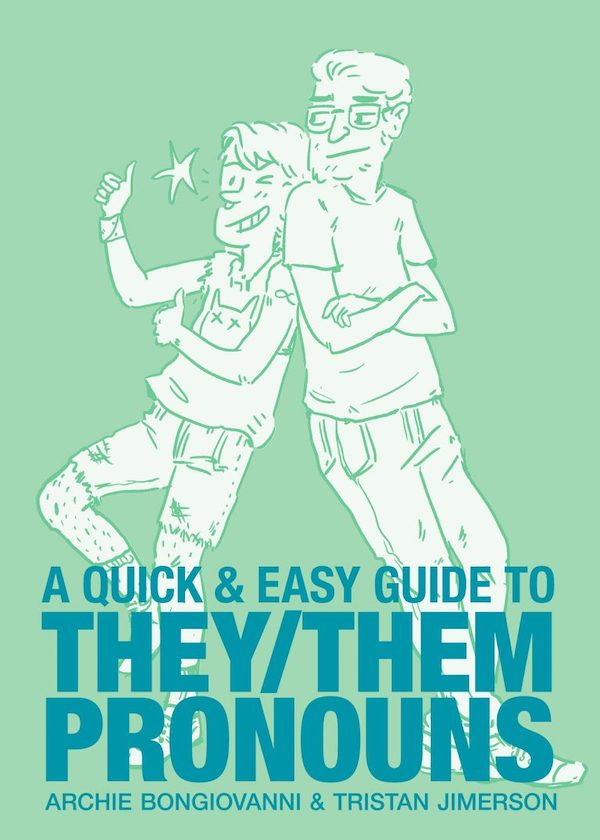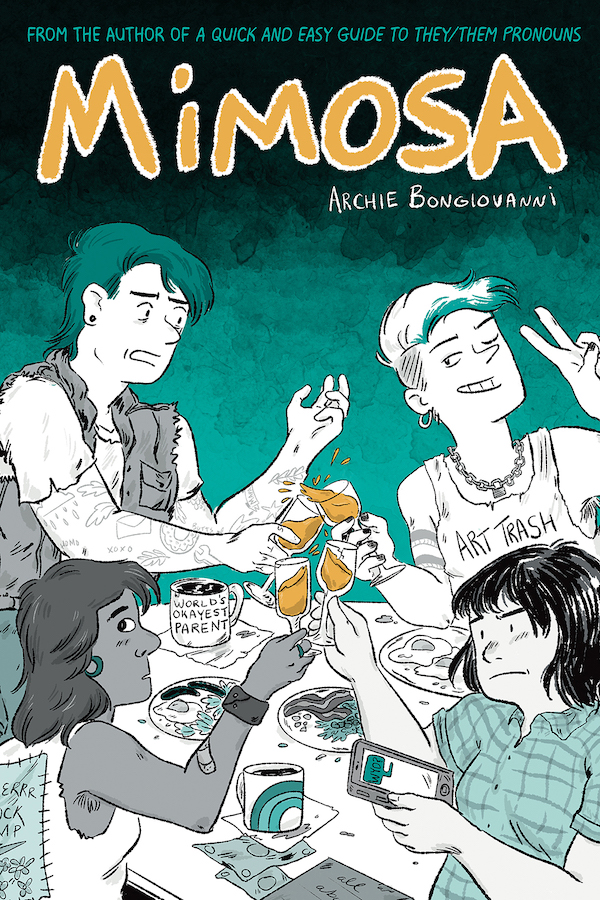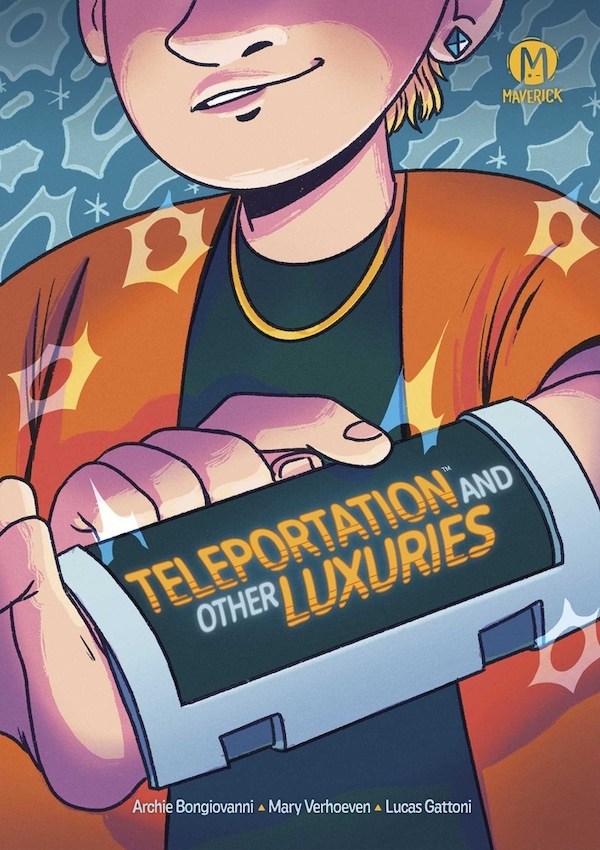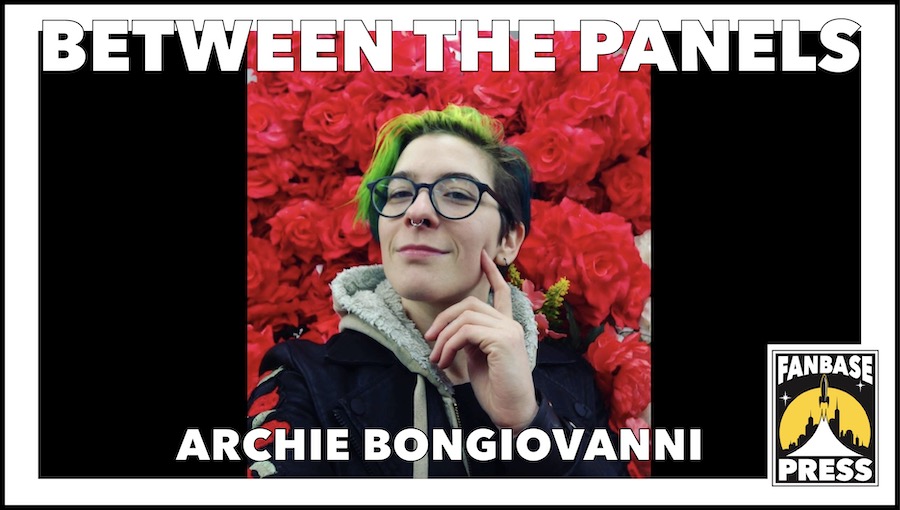“Between the Panels” is a monthly interview series focusing on comic book creators of all experience levels, seeking to examine not just what each individual creates, but how they go about creating it.
There are those who realize their professional calling later in life, and then are those who target working in comics early on; spend high school and college making their own zines; and later use that work as a springboard into the larger industry. Such is the tale of Ignatz and Harvey-nominated Archie Bongiovanni, whose first graphic novel back in 2018 has led to a unique, exciting—and expanding —list of credits.
First off, the basics…
Your specialties (artist/writer/letterer/inker/etc.): Artist / Writer
Your home base: Minneapolis, MN
Website: archiebongiovanni.com
Social Media
Instagram: @babywrist
Twitter: @grease_bat
Bluesky: @babywrist.bsky.social
Fanbase Press Contributor Kevin Sharp: I start with the same question for all guests: Why comics? What is it specifically about this medium that attracts you as a creator?
Archie Bongiovanni: Ever since I was in high school, I was obsessed with drawing my own comics. I think it’s such a fascinating medium, there’s so much one can tell and share in just a few little lines. I love how brains work reading comics, making sense of what happens between panels, interpreting the juxtaposition between text and images and how we instinctively read two dots as eyes along with the multitudes of emotions that can be expressed in such. Also, they’re just fun!
KS: When did comics first become part of your life as a reader? Were they something you had easy access to growing up, either through traditional “floppies,” collected editions, newspaper cartoons, etc.?
AB: I started reading, ironically, Archie Comics. I would beg my parents to buy me one from the supermarket. When my dad brought me to the comic book store, it was over for me. I was introduced to manga and couldn’t get enough. I was never interested in superheroes, I liked slice-of-life comics about folks that felt like me.
KS: Which store was that?
AB: It was called The Comic Shop and I recently visited it and saw my own comics in the shop, which was very cool for me! I remember going in for Archie Comics and I think I was waiting for my dad to finish something up at a store next door so I wandered around.
KS: And what caught your attention about manga over the other items for sale in there?
AB: Like I said, I wasn’t interested in the superhero comics but my eye found a small shelf of manga on the bottom shelf in the back. I was initially interested probably because these comics were more adult than the ones I was reading, but also because they starred women and girls. The reason I think I overlooked superhero comics at the time was because they were all men and I couldn’t connect to them-thankfully, this isn’t true nowadays!

KS: Did you gravitate toward any favorite titles?
AB: I liked so many comics! I was particularly fond of Happy Mania by Moyocco Anno when I was in high school. It was funny, dramatic, and a bit sexy so I was very intrigued! As I got older, the types of comics I enjoyed expanded and now I love so many comics. I really love walking around a zine fest or an indie comic con and just seeing what wild things people’s imaginations will create. I think that’s another thing I love about this medium, it’s literally so expansive and varied.
KS: How about your creative “diet” aside from comics? What kinds of things did you read or watch that really fed your mind growing up?
AB: I loved anime when I was a high schooler, as well. I spent many hours watching YouTube anime music videos and renting VHS from the local anime rental store. I grew up in Fairbanks, Alaska, and this was the only way to rent anime! I cannot believe my small town had something so specific in the early 2000s, but I’m grateful! Other than that, I was a voracious reader and loved all types of books. I feel that my creative diet now is more expansive! I really am influenced by my local queer community and the art and spaces they create.
KS: Looking back, was there a particular comic book story or storyline that really had an impact on younger you?
AB: [T]here wasn’t really a single story or comic that influenced me as much as discovering indie comics and zines as a whole impacted me. Growing up, I didn’t realize you could create mini-comics, self-publish your work, or create anthologies about whatever you want as a zine. I had a very narrow idea of what comics looked like and with that a narrow idea of what publishing and success looked like. It wasn’t until I was in college for a few years that I discovered mini-comics and zines while attending Minneapolis College Of Art And Design. The first zinefest I went to blew my mind. I suddenly became aware that I could produce whatever I wanted all on my own and that these comics and zines could be about anything.
KS: What about that discovery made it so special for the person you were at the time?
AB: This was important because it totally changed not just what I was drawing, but also completely altered my career and changed how I define success for myself. After graduating, I didn’t get an art job and worked at a restaurant creating mini comics and zines after my shifts ended. I was able to explore my gender, my sexuality, creating my own characters and comics with freedom. As such, I was also able to share these parts of myself with others easily. Even though I didn’t have anything published, I felt like a success because I was creating things I loved. One of the zines I made was with my friend Tristan Jimerson: A Cheap And Easy Guide To They/Them Pronouns. We printed it on neon paper and sold it for $2-3. I got really tired of explaining they/them pronouns over and over again, and Tristan was a cisgender pal who had experience learning and adapting his language and so hoped by combining our efforts we could help bridge the gap of understanding when it comes to using non-binary pronouns. After a few years of printing this zine, it ended up on an editor’s desk. This is what helped launch my career in the publishing world, but I wouldn’t have ever gotten there without self-publishing. I still self-publish zines on my own and love it and think it’ll always be a part of my creative process.

KS: We’ll come back that editor shortly. You mentioned making comics in high school, but was that something you thought of as a potential “real” job, or was it strictly a fun hobby for you?
AB: I have an entry in my high school journal where I talked about how I don’t care what else I’m doing, as long as I’m also making comics. So even growing up, I think I realized that it would be incredibly tough to make a living off just comics! It never felt quite like a hobby though. Yes, it was fun and I still draw comics for fun, but I also worked hard on figuring out my style, improving my art —or working with my artistic weaknesses— and learning about the creative business of making your art a career. It truly is amazing that I’m able to call it a job now, but it does take constant refiguring to be able to live off of my comics and art. So yeah, it’s fun and rewarding and I do it for myself but it’s not a hobby! My current hobby is playing tabletop board games, collecting haunted dolls and soon I want to teach myself screenprinting!
KS: How did you end up choosing MCAD for art school?
AB: After high school I wanted to stay close to home as my mom was recently diagnosed with multiple sclerosis and I wasn’t sure how that’d look for her. After attending for a year, I realized it wasn’t as scary as I first thought and she and my dad encouraged me to attend an art school. I remember Googling “Art School College” back then —this would be in 2007/2008— and only two schools popped up. I visited SCAD and immediately got heat stroke and decided to go to the second school that showed up on the list. MCAD had an actual BFA in Comics Art that I could get. I’m not sure going to college was financially the smartest choice for starting a career in comics, but it did work out for me.
KS: Did you have parental support for this path? I know many parents would advise a “safe” major to have some security…
AB: My parents always encouraged us to follow whatever path we wanted to, finances be damned. They had a very YOLO outlook on life. I found out later that when I transferred to MCAD, my parents actually thought I wasn’t that good at art! So, they knowingly encouraged me to do what I wanted despite assuming I’d fail at it.
KS: What was different, other than your skill level, about the zines you made during this time vs. the comics you’d been making in high school?
AB: In high school, I was creating comics about my friends and also mirroring the comics I was reading. So, a lot of love triangles and drama and fantasy. Which I think makes sense for that age range, I was experimenting with storytelling and trying to improve my skills. I’d sit down and say, “I’m going to learn to draw a hand holding a pencil today,” and then sit and try and perfect it. After college, when I got into zines, my work because a lot more introspective. This is when I was less focused on figuring out art and storytelling and more focused on figuring out myself and who I was as a person. They were personal and about my life which was both meant to help me understand myself but also help me connect with others.
KS: Talk a little about your post-college zine work. How did you learn about publishing to get those printed? And once they were printed, what kind of hustle was required as far as distribution?
AB: I heard about zines and mini-comics in college and was taught by Zak Sally how to layout and print zines. As far as distribution goes, I tabled at local and nearby zinefests and small press comic conventions. I also got involved at a volunteer-run independent bookseller called Boneshaker Books [in Minneapolis]. That was the first place I consigned my zines and then I researched other independent and small comic and zine shops to sell my work at such as Quimby’s in Chicago and Microcosm in Portland.
KS: Circling back to your work ending up in front of that editor… Was that something you engineered or was it more of a happy accident?
AB: It was most serendipitous but also something I worked on! I was doing a big push personally to get my zines read as much as possible and pushing to get eyes on my work who weren’t just local. I contacted various stores that consigned zines and got my work in different cities outside of the Midwest. The zine was being sold out in Portland and that’s how it ended up on the desk of Ari Yarwood, who was formally working at Oni Press.

KS: What was your inspiration for diving into the full graphic novel format for A Quick and Easy Guide To They/Them Pronouns?
AB: [It] started out as a short zine originally called A Cheap And Easy Guide To They/Them Pronouns. It was Ari [Yarwood]’s idea to adapt it into a larger graphic novel that was both family and work friendly. I’ve been so pleased by how helpful it’s been to people and feel really grateful it’s still being distributed and sold —and still useful! Also fun note about [Ari]: We worked on A Quick And Easy Guide in 2018 and this year we’re working together again, but on a totally different secret project with a different publisher! I was so excited when I heard we’d be working together again!
KS: We’ll finish up with two hypotheticals. First, I can hook you up to a machine Matrix-style and immediately upload into your brain any skill or ability you don’t currently have. Tell us about your new expertise…
AB: I am not handy in the slightest, but I think it would be so cool to be able to naturally know how to do basic handiwork around the house! I feel like knowing how to fix up spaces and appliances on my own would be so cool! And freeing! Not only would it save me money, but I could go to my pals’ houses and fix their dishwashers, laundry machines, upgrade their cabinets and whatever. The idea of this being able to be something I instinctively knew how to do instead of struggling with watching hours of YouTube videos sounds dreamy.
KS: Now imagine a Comic Book Hall of Fame and you get to induct any single title from any era of this medium. What book is getting your plaque?
AB: This question made me spiral into thinking about a bunch of amazing comics, and I wasted an hour of my day contemplating my bookshelf trying to pick just one book! What a terrible question – haha! While there’s so many that I would want to pick, I think I would go with Gender Queer: A Memoir by Maia Kobabe. It’s such an important graphic novel, not just for LGBTQ folks and other readers who connect with Kobabe’s story, but also an important graphic novel that symbolizes the anti-LGBTQ movement happening in America today. It’s a symbol of resistance to book banning and the anti-trans rights movement and I think it should be celebrated.

KS: Please let readers know what you have out now or what you have coming out this year they should be on the lookout for…
AB: Thank you so much for interviewing me and asking such smart and insightful questions! Right now, I’m still celebrating my newest original graphic novel, Mimosa, about a bunch of queer adults navigating the implosion of their chosen family. Later on this year, Maverick is putting out Teleportation and Other Luxuries, a delightful YA comic I wrote and the talented Mary Verhoeven illustrated about a bunch of teen scientists!
KS: Thanks for chatting, Archie!

